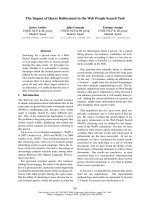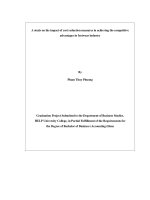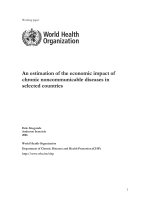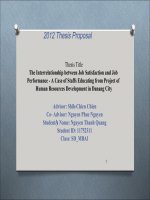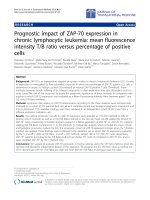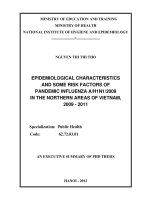Impact of risk factors on business results of life insurance products in insurance companies in Hue city
Bạn đang xem bản rút gọn của tài liệu. Xem và tải ngay bản đầy đủ của tài liệu tại đây (851.54 KB, 11 trang )
Hue University Journal of Science
ISSN 2588–1205
Vol. 128, No. 5C, 2019, pp. 55–65; DOI: 10.26459/hueuni-jed.v128i5C.5117
IMPACT OF RISK FACTORS ON BUSINESS RESULTS OF LIFE
INSURANCE PRODUCTS IN INSURANCE COMPANIES
IN HUE CITY
Duong Dac Quang Hao*, Nguyen Thi Minh Hoa
University of Economics, Hue University, 99 Ho Dac Di St., Hue, Vietnam
Abstract: On the basis of the leveraging Monte Carlo simulation method and @Risk – a risk analysis
software, this study aims to identify and analyse the impacts of the potential risk factors on business
results of life insurance products in the insurance companies in Hue city. Both the qualitative and
quantitative method is applied. Data were collected from interviewing the leaders, financial managers and
senior consultants at four most representative life insurance companies in the area, namely Bao Viet life
insurance, Prudential, AIA, and PCI Sun Life using the DELPHI technique. The following findings are
found. Firstly, besides the identified events, 10 other types of risks could affect the business results of life
insurers. Secondly, these types of risks have varied frequencies and levels of impact on the three studied
variables of the simulation model. Finally, the risk of rumours and the risk of new competitors appear to
be the most significant dangers to the expected profits of life insurance companies.
Keywords: Monte Carlo simulation, @Risk, Delphi technique, life insurance
1
Introduction
In Vietnam, the insurance industry has started since 1993. However, according to the
Department of Insurance Supervisory and Authority, approximately 9.7% of the Vietnamese
population has bought life insurance so far [3]. Along with the huge market development
opportunities and the rapid growth of the economy in the coming time, Vietnam is recognised
as one of the most lucrative markets for life insurers in the South East Asian region [5]. In terms
of domestic enterprises, to exploit this opportunity, they need to make breakthrough changes.
In fact, 62.5% of the market share in Vietnam’s life insurance industry is occupied by foreign
insurers (such as AIA and Prudential). This is rooted in the weaknesses of domestic enterprises
in risk management activities [17]. Weak ability to control business risks leads to severe impacts
on company reputation, customer relationship, and profitability [12].
Regarding the academic aspect, the topic of assessing risk factors that affect business
outcomes has attracted great attention of researchers worldwide [5]. Much research has been
implemented to develop the evaluation scale of identified and unidentified risk events [1, 12,
13]. Some authors are interested in clarifying the consequences of risks on business activities in
the insurance companies [4, 14]. Despite the increase in the number of related works, there are
* Corresponding:
Submitted: February 19, 2019; Revised: March 15, 2019; Accepted: March 15, 2019
Duong Dac Quang Hao, Nguyen Thi Minh Hoa
Vol. 128, No. 5C, 2019
still gaps in the knowledge base. There is still a lack of efficient quantitative models to measure
the level of identified and unidentified risk events. Further, the relationship between these
events and financial results of life insurers has not clearly been quantified yet. Besides, although
numerous scholars in risk management have developed a quantitative scale to assess the
business risks in developed countries [4], the evaluation scale of these identified risks was not
thoroughly tested in the practice of a developing country, such as Vietnam [13].
Stemming from these urgent problems, the authors carried out this study to analyse the
risks that affect the selling process of life insurance products in some typical insurance
companies in Hue city. They also propose feasible solutions to help life insurers in Hue city
identify, mitigate and overcome the risks.
2
Literature review
One of the first definitions of risk is attributed to Bernoulli, who in 1738 proposed measuring
risk with the geometric mean and minimizing risk by spreading it across a set of independent
events [21]. Accordingly, the traditional definition of risk is measured by two combined
variables: a) frequency of occurrence (probability) of the “risky” event, i.e., the number of times
the risky event is repeated in a predetermined period, and b) extent of the consequences
(magnitude) that the event generates, i.e., all the results of its occurrence [15].
According to Verbano and Venturini, a risk is the possibility of an abnormal event with
consequential consequences or results that are not expected. A risk may comprise positive and
negative consequences of an event. Risk has four basic characteristics: randomness, objectivity,
uncertainty (or unpredictable), and duality [20].
In business, risk can be caused by external factors such as risk arising from the macro
environment (such as economic status, political situation, social features, and science and
technology), micro-environments (such as competitors, customers, suppliers, and alternative
products), or may also come from internal factors (such as risk related to personnel issues,
strategies, products, and company policies) [20].
The International Organization for Standardization (ISO 31000) identifies the following
principles of risk management that should create value, be an integral part of the organizational
processes, be part of decision making that explicitly addresses uncertainty, be systematic and
structured, be based on the best available information, be tailored, take into account human
factors, be transparent and inclusive, be dynamic, iterative and responsive to change, and be
capable of continual improvement and enhancement.
The adoption of a risk management methodology can lead firms to reduce the
uncertainty in enterprise’s management, to ensure continuity in production and trading in the
market, to decrease the risk of failure, and to promote the enterprise’s external and internal
56
Jos.hueuni.edu.vn
Vol. 128, No. 5C, 2019
image. Therefore, risk management creates business value, maximizing business profits by
minimizing costs [10].
Regarding the studies on business risks for life insurers and insurance companies in
general, most of the studies only look at the risk identification [6], trace the source of risk [14] or
analyze the financial consequences when risks occur [2]. These studies have not considered the
use of risk measurement tools, either compared the random effects of business risks. This study
thus will utilise the Monte Carlo simulation method to create a relatively distinct research
platform.
The Monte Carlo simulation method is a broad class of computational algorithms that
rely on repeated random sampling (using pseudo-random numbers) to obtain numerical
results. Its essential idea is using randomness to solve problems that might be deterministic in
principle. The result of this method is more accurate (asymptotic in the right result) when the
number of iterations increases [3]. It is mainly used in three problem classes: optimization,
numerical integration, and generating draws from a probability distribution [7].
In this study, on the basis of using @Risk – a risk analysis software, the Monte Carlo
method is leveraged to evaluate the impact of defined variables (caused by negative causes) and
undefined variables (caused by difficult-to-identify causes) to measurement and targeted
variables. By this way, the fluctuation of these variables, under the impact of different types of
risks, could be analysed and evaluated clearly.
3
Methods
In this study, the authors utilized both qualitative and quantitative data. Namely, the secondary
data were collected from the Department of Insurance Supervisory and Authority, Thua Thien
Hue Statistical Office, and Association of Hue enterprises. These data sources provide an
overview of business activities on life insurers in Hue city, general assessments on their
performance, and the financial results of these enterprises.
Primary data were then collected by using the DELPHI technique. This is a structured
communication technique, derived from symmetric prediction methods and interactive
forecasts based on panel answers of experts' questions [16].
The sample size consists of 2 interviewed groups (more than 3 people/group) and 12
individuals from 4 most typical selected life insurance companies in Hue city. Within a country,
the consumer culture and other elements of the business environment are quite similar.
Therefore, studying the Hue case could partially generalise for the whole of Vietnam.
The interview sequence for collecting quantitative data goes through 3 steps:
Step 1: Personal interview with 4 accountants from 4 selected companies. These
57
Duong Dac Quang Hao, Nguyen Thi Minh Hoa
Vol. 128, No. 5C, 2019
interviewees provide the financial reports, detailed information about the financial impacts of
risks, and the variability of cost, revenue, profit over the research time.
Step 2: Personal interview with 8 people (leaders, managers of the sales department and
senior consultants from 4 selected companies). These interviewees help to verify and add
explanations on the provided data in step 1. They also help to estimate the changes in cost,
revenue, and profit when risks occur.
Step 3: Interview 2 research groups from 4 selected companies. These groups help to
review the analytic results and figure out the feasible solutions for solving the negative impacts
of risks.
During this process, in each step, the interviewees receive a summary of all predictions
from the prior interviewees and the interpretation of these predictions. The interview contents
from the previous step thus were evaluated in the following steps. Similarly, the results from
the following steps are also considered by the members in the previous step. This process
enables to have a high consensus before the final result are obtained.
After revising the collected data and building the simulation model, we used @Risk to
analyze the risks in the selling process of life insurance products at selected insurance
companies in Hue city. This tool helps to show virtually all possible outcomes when risks
happen, and it also tells us how likely these risks are to occur.
4
Research findings
4.1
Building simulation model
Figure 1. Framework of Monte-Carlo simulation model in this study
As a prerequisite for risk analysis based on the Monte Carlo simulation method (Figure
1), the authors conducted qualitative surveys. The personal interviews with 4 accountants from
4 selected companies provide detailed information about the financial impacts of risks over the
studied period. This information is then verified in the second interview step, which is
described in section 3. The interviewees propose three most important measurement variables
representing for the business results at Hue life insurers, including the number of life insurance
contracts, average price, and average revenue. Besides, 10 unknown events are listed and
58
Jos.hueuni.edu.vn
Vol. 128, No. 5C, 2019
analysed (Table 1). These risks do not include defined events, which occur regularly (such as
the frequent fluctuation in human resource and seasonality in business) and are not the main
targeted objects in this study.
Table 1. Simulation model (including 10 unknown risks only)
Number of contract
Unknown events
Cost/ contract
Revenue/ contract
Frequency
%
impact
Frequency
%
impact
Frequency
%
impact
Risk of organizing
unsuccessful workshops
(finding customers)
0.15
–0.05
0.17
0.04
–
–
Risk of unsuccessful cold
canvassing
0.18
–0.05
0.25
0.05
–
–
Risk of appearing new
competitors
0.12
–0.06
0.16
0.05
0.11
–0.11
Risk of rumors
0.20
–0.11
–
–
0.16
–0.10
Risk of changing insurance
policies
0.11
0.04
0.12
0.03
–
–
Risk of losing key personnel
0.10
–0.12
–
–
–
–
Risk of sudden increase in
the number of compensated
contracts
–
–
0.52
0.04
–
–
Risks of canceling a large
number of contracts
0.13
–0.04
0.26
–0.04
0.04
–0.04
Risk of temporary
invalidation of a series of
contracts
0.11
–0.14
–
–
0.06
–0.06
–
–
–
–
0.06
–0.07
Risk of suddenly adjusting a
large number of contracts
"–": Risks affect negligibly to measurement variable
4.2
Analyze the impact of risks on measurement variables
After building simulation models for the studied year and the base year, we evaluated
the risks affecting the business results of life insurance products in 4 following aspects, which
are the number of life insurance contracts, the cost of a life insurance contract, the revenue of a
life insurance contract, and the profitability of life insurers. The evaluation was conducted by
randomly iterating the simulation model 10,000 times.
59
Duong Dac Quang Hao, Nguyen Thi Minh Hoa
Vol. 128, No. 5C, 2019
Analyse risks affecting the number of sold life insurance contracts
The analysis results show that the identified events cause differences in the number of
contracts every year. This number ranges from about 325 to 1357 contracts. These identified
events relate to changes in the market demand, competitors, insurance companies' strategies
and policies, skills of the consulting staff, sales staff, etc (table 2). Besides, the number of life
insurance contracts is also affected by 8 different types of unknown risks. The risk of rumours is
the most significant impact on this studied variable (regression coefficient –23,580, correlation
coefficient –0.12).
The risk of temporary invalidation of a series of contracts creates the widest range of
impact level that varies from 683.82 to 801.34 contracts/year. This means that this risk is the
most difficult to control and prospect among the risks affecting the number of contracts.
Table 2. Results of comparative analysis between researched year and base year
Unit: contract per year
Criteria
Studied year
Base year
Minimum
value
Mean value
270.741
325.370
781.569
840.500
Maximum
value
1,401.248
1,356.619
Criteria
Studied Year
Base year
Standard
deviation
Median
209.666
213.116
476.425
840.471
Mode
436.958
837.883
Analyse risks affecting the cost of a life insurance contract
The analysis results show that the cost of a life insurance contract is possibly affected by 6
unknown risk events: unsuccessful cold canvassing, a sudden increase in the number of
compensated contracts, cancelling a large number of contracts, new competitors, unsuccessful
workshops, and change in the insurance policy. With the impacts of these risks, the fluctuation
range of cost per life insurance contract changes. The lowest is from 1.589 to 1.692 million
VND/contract/year, and the highest is from 18.707 to 19.398 million VND/contract/year.
Besides, the risk of a sudden increase in the number of compensated contracts (regression
coefficient –0.289, correlation coefficient 0.04) and risk of unsuccessful cold canvassing
(regression coefficient 0.288, correlation coefficient 0.03) are two factors creating the greatest
impact on this studied variable (figure 2).
60
Jos.hueuni.edu.vn
Vol. 128, No. 5C, 2019
Figure 2. Approximate range of value of the studied variable: cost per contract in 10,000 iterations
Analyse risks affecting the revenue of a life insurance contract
There are 5 unknown events that affect the studied variable – revenue per life insurance
contract. The risk of rumours (regression coefficient –0.887, correlation coefficient –0.05) and the
risk of new competitors (regression coefficients –0.769, correlation coefficient –0.03) have the
greatest impacts. On the other hand, the cumulative effects of the 5 events also change the
fluctuation range of revenue per life insurance contract. The lowest is from 2.812 to 3.313
million
VND/contract/year,
and
the
highest
is
from
111.651
to
111.744
million
VND/contract/year.
90% of 10,000 random iterations has a revenue per contract ranging from about 8.9 to 86.0
million VND.
Figure 3. The impact range of each risk to the revenue per contract
61
Duong Dac Quang Hao, Nguyen Thi Minh Hoa
Vol. 128, No. 5C, 2019
Analyse risks affecting the profitability of life insurers
The profit is considered as the targeted variable of the study. This variable is calculated
on the basis of the variability of the three studied variables in the simulation model. Without the
identified events, the analysis results of the impact of 10 unknown events on the variability of
profits reveal that the risk of rumor (regression coefficient –1,111.49, correlation coefficient
–0.06), risk of new competitors (regression coefficients –996,84, correlation coefficient –0.03),
and risk of temporary invalidation of a series of contracts (regression coefficient –601.94,
correlation coefficient –0.04) have the greatest impact on the targeted variable – profit.
Figure 4. Regression coefficient on the impact level of different risks to profit
Another statistic shows that with the negative and positive impacts of 10 unidentified
risks, the average profit (mean) of the life insurers has declined from 19,463.49 million
VND/year in the base year (assume that unknown events do not appear) to 16,494.96 million
VND/year in the studied year. The average loss is 2,968.53 million VND/year.
Figure 5. Comparison of the approximate range of profit between the studied year and the base year
62
Jos.hueuni.edu.vn
5
Vol. 128, No. 5C, 2019
Discussion and conclusion
The identification and management of risk factors that affect business performance are always
the greatest concern of business leaders and academic scholars around the world, not only in
insurance but also in many other sectors. In this study, the authors develop and analyse the
simulated model on the basis of the Monte Carlo method to evaluate the impact of defined and
undefined variables to the studied variables.
The findings have supplemented the knowledge about risks in the life insurance
business. The qualitative research step has figured out 4 major groups of risk that affects the
business results of the life insurance companies in Hue city. They are the risk group related to
accessing customers (including unsuccessful cold canvassing and organizing unsuccessful
workshops), the risk group related to the market (including new competitors and rumors), the
risk group related to the internal issues (including changing the insurance policies and losing
key personnel), and the risk group related to the customers' problems (including the sudden
increase in the number of compensated contracts, canceling a large number of contracts,
temporarily invalidating a series of contracts, and the sudden adjustment of a large number of
contracts). These findings help to clarify the research results of Baranoff and Sager, which
mentioned asset risk, product risk, and capital in the life insurance industry.
Another finding is the number and impact level of unknown events on the three studied
variables of the simulation model. Namely, there are 8 unknown risks that affect the number of
contracts, 6 risks affecting the cost per each contract, and 5 risks affecting the revenue per each
life insurance contract. This is supported by the research of Gründl et al. and Grosen et al.
[9, 10]. This finding helps life insurers arrange the priority order of the controlled and
prevented measures to the mentioned risks.
Referring to the targeted variable – the profitability of life insurers, the study found that
the risk of rumours, the risk of new competitors, and the risk of cancelling a large number of
contracts have the greatest impact on the expected profits of life insurance companies. This
finding is partially supported by Cummins and Santomero [2].
On the basis of the analysis results and group discussion among risk management
experts, the study offers 4 groups of solutions to limit the negative effects of unknown events on
the business outcomes of insurance companies in the locality, specifically:
Screening the invited customers to the workshops, understanding their needs
thoroughly, and enhancing customer service networks.
Simplifying transaction procedures, checking the truthfulness of information declared
on the contract more strictly.
63
Duong Dac Quang Hao, Nguyen Thi Minh Hoa
Vol. 128, No. 5C, 2019
Providing the information on insurance packages clearly and transparently and
reducing internal costs.
Creating training opportunities, improving knowledge and professional capacity for
employees, expanding diversification of agent channels, as well as considering
changes in product packages.
In summary, on the basis of risk theories in general and risks in the life insurance
business in particular, this study helps life insurers identify and analyse the impact features of
traditional risks and unknown risks in their business process. Regarding the limitation of this
study, due to the shortage of financial resources and time constraint, the research scope of this
study just focuses on the Hue market. In order to give conclusions for the whole Vietnam case,
we need a bigger project. Additionally, the collected data have certain shortcomings. This is
rooted in the relative evaluation criteria and subjective opinions of interviewees. Therefore, in
the future, there should be further research with more focused research objects and data
collected for a longer time (such as supervising throughout the process of occurred risks).
Moreover, there should be new studies focusing on clarifying the effectiveness of risk
prevention methods currently used by life insurers.
References
1.
Baranoff, E. G. & Sager, T. W. (2002), The relations among asset risk, product risk, and
capital in the life insurance industry, Journal of banking & finance, 26(6), 1181–1197.
2.
Cummins, J. D. & Santomero, A. M. (Eds.). (2012), Changes in the life insurance industry:
efficiency, technology and risk management, Springer Science & Business Media, vol .11.
3.
Department of Insurance Management and Supervision (2014), Global Insurance Market
Newsletter, on January 15, 2014, Ministry of Finance, No. 22 + 23 (40 + 41).
4.
Eckles, D. L., Hoyt, R. E. & Miller, S. M. (2014), Reprint of: The impact of enterprise risk
management on the marginal cost of reducing risk: Evidence from the insurance industry.
Journal of Banking & Finance, 49, 409–423.
5.
ERC (2013), Global insurance review 2013 and outlook 2014/15, November 2013, Economic
Research & Consulting, Swiss Re.
6.
Gahin, F. S. (1971) Review of the Literature on Risk Management, The Journal of Risk and
Insurance 38(2), 309–313.
7.
Gamerman, D. Markov Chain Monte Carlo: Stochastic Simulation for Bayesian Inference, Boca
Raton, FL: CRC Press, 1997.
8.
Gilks, W. R., Richardson, S. & Spiegelhalter, D. J. (Eds.), Markov Chain Monte Carlo in
Practice. Boca Raton, FL: Chapman & Hall, 1996.
64
Jos.hueuni.edu.vn
9.
Vol. 128, No. 5C, 2019
Grosen, A. & Jørgensen, P. L. (2002), Life insurance liabilities at market value: an analysis of
insolvency risk, bonus policy, and regulatory intervention rules in a barrier option
framework, Journal of risk and insurance, 69(1), 63–91.
10. Gründl, H., Post, T. & Schulze, R. N. (2006), To hedge or not to hedge: Managing
demographic risk in life insurance companies, Journal of Risk and Insurance, 73(1), 19–41.
11. Hoyt, R. E. & Liebenberg, A. P. (2008), The value of enterprise risk management: Evidence
from the US insurance industry. In an unpublished paper, accessed at http://www. aria.
org/meetings/2006papers/Hoyt_Liebenberg_ERM_070606. pdf.
12. Hoyt, R. E. & Liebenberg, A. P. (2011), The value of enterprise risk management. Journal of
risk and insurance, 78(4), 795–822.
13. Jason R. Thacker, CAIA (2011), Risk Management in Insurance, Business program consultant
and actuarial development program, Colonial life.
14. Judy Feldman Anderso & Robert L. Brown, Risk and insurance, Education and examination
committee of the society of actuaries.
15. Kevin Dowd, David L. Bartlett, Mark Chaplin, Patrick Kelliher and Chris O’Brien (2007),
Risk management in UK insurance industry: The changing state of practice, Centre for Risk &
Insurance Studies, University of Nottingham.
16. Luciano Machain (2009), @Risk: Monte Carlo Simulation in Excel, National University of
Rosario, Argentina.
17. Ministry of Finance (2015), Vietnam Insurance Market Supervision 2014, Finance Publishing
House, Hanoi 2015.
18. Ogawa, S. & Piller, F. T. (2006), Reducing the risks of new product development, MIT Sloan
management review, 47(2), 65.
19. Palisade Corporation, Guide to RISKOptimizer: Simulation optimisation for Microsoft Excel.
20. Verbano, C. & Venturini, K. (2013), Managing risks in SMEs: A literature review and
research agenda, Journal of technology management & innovation, 8(3), 186–197.
21. Bernoulli, D. (1954), Originally published in 1738, translated by L. Sommer. Exposition of a
new theory on the measurement of risk, Econometrica, 22(1), 22–36.
65

